Constructal Design of Elliptical Cylinders with Heat Generating for Entropy Generation Minimization
Abstract
1. Introduction
2. Heat Source Model and Numerical Method
2.1. Geometric Model
2.2. Heat Transfer Model
2.3. Numerical Method
3. Results and Analyses
3.1. Effects of Heat Generating Intensity on Heat Dissipation Performance
3.2. Effects of Thermal Conductivity of Heat Source on Heat Dissipation Performance
4. Conclusions
Author Contributions
Funding
Acknowledgments
Conflicts of Interest
Nomenclature
| b | Ratio |
| Cε1, Cε2, Cμ | Empirical constants |
| c | Constant pressure specific heat capacity, J·kg−1·K−1 |
| F | Volume force vector, N |
| H | Thickness of pedestal, m |
| Hs | Height of heat source, m |
| Dimensionless height | |
| I | Unit matrix |
| k | Turbulent kinetic energy, J |
| L | Length of pedestal, m |
| La | Short axis of ellipse, m |
| Lb | Long axis of ellipse, m |
| Pk | Generation term of turbulent kinetic energy |
| Pt | The total heating power of heat sources |
| Q | Heat source item including viscous dissipation and pressure work, W·m−3 |
| q | Heat flux vector, W·m−2 |
| q″ | Heat generating intensity, W·m−3 |
| Entropy generation rate, W·K−1 | |
| Dimensionless entropy generation rate | |
| T | Matrix transpose operator symbol |
| T | Temperature, K |
| Dimensionless hot spot temperature | |
| U | Velocity vector, m/s |
| W | Width of pedestal, m |
Greek Symbols
| ε | Turbulent dissipation rate, % |
| λ | Thermal conductivity, W·m−1·K−1 |
| μ | Dynamic viscosity coefficient, Pa·s |
| μT | Turbulent viscosity coefficient, Pa·s |
| ρ | Density, kg·m−3 |
| σk, σε | Empirical constants |
Subscripts
| b | Heat conductive pedestal |
| f | Fluid |
| i | Number of heat source |
| in | Inlet |
| opt | Optimum |
| s | Heat source |
Abbreviations
| EGM | Entropy generation minimization |
| EGR | Entropy generation rate |
| DEGR | dimensionless entropy generation rate |
References
- Yousef, A.; Mohammad, Z.T.; Mohammad, M.H.; Nima, G. Effect of a micro heat sink geometric design on thermo-hydraulic performance: A review. Appl. Therm. Eng. 2020, 170, 114974. [Google Scholar]
- Khattak, Z.; Ali, H.M. Air cooled heat sink geometries subjected to forced flow: A critical review. Int. J. Heat Mass Transf. 2019, 130, 141–161. [Google Scholar] [CrossRef]
- Bejan, A. Street network theory of organization in nature. J. Adv. Transp. 1996, 30, 85–107. [Google Scholar] [CrossRef]
- Bejan, A. Constructal-theory network of conducting paths for cooling a heat generating volume. Int. J. Heat Mass Transf. 1997, 40, 799–816. [Google Scholar] [CrossRef]
- Reis, A. Constructal theory: From engineering to physics, and how flow systems develop shape and structure. Trans. ASME Appl. Mech. Rev. 2006, 59, 269–282. [Google Scholar] [CrossRef]
- Chen, L.G. Progress in study on constructal theory and its applications. Sci. China Tech. Sci. 2012, 55, 802–820. [Google Scholar] [CrossRef]
- Bejan, A. Constructal thermodynamics. Int. J. Heat Tech. 2016, 34, S1–S8. [Google Scholar] [CrossRef]
- Bejan, A.; Errera, M.R. Complexity, organization, evolution, and constructal law. J. Appl. Phys. 2016, 119, 074901. [Google Scholar] [CrossRef]
- Chen, L.G.; Feng, H.J.; Xie, Z.H. Generalized thermodynamic optimization for iron and steel production processes: A theoretical exploration and application cases. Entropy 2016, 18, 353. [Google Scholar] [CrossRef]
- Feng, H.J.; Chen, L.G.; Xie, Z.H. Multi-disciplinary, multi-objective and multi-scale constructal optimizations for heat and mass transfer processes performed in Naval University of Engineering, a review. Int. J. Heat Mass Transf. 2017, 115, 86–98. [Google Scholar] [CrossRef]
- Lorente, S. The constructal law: From microscale to urban-scale design. Annu. Rev. Heat Transf. 2017, 19, 335–368. [Google Scholar] [CrossRef]
- Chen, L.G.; Xiao, Q.H.; Feng, H.J. Constructal optimizations for heat and mass transfers based on the entransy dissipation extremum principle, performed at the Naval University of Engineering: A review. Entropy 2018, 20, 74. [Google Scholar] [CrossRef]
- Bejan, A. Constructal law, twenty years after. Proc. Rom. Acad. Ser. A Math. Phys. Tech. Sci. Inform. Sci. 2018, 18, 309–311. [Google Scholar]
- You, J.; Feng, H.J.; Chen, L.G.; Xie, Z.H. Constructal optimization for cooling a nonuniform heat generating disc-shaped area by conduction. Entropy 2018, 20, 685. [Google Scholar] [CrossRef]
- Lorente, S.; Bejan, A. Current trends in constructal law and evolutionary design. Heat Transf. Asian Res. 2019, 48, 357–389. [Google Scholar] [CrossRef]
- Bejan, A.; Gunes, U.; Sahin, B. The evolution of air and maritime transport. Appl. Phys. Rev. 2019, 6, 021319. [Google Scholar] [CrossRef]
- Bejan, A. The evolving design of our life. Interdiscip. J. Lands. Archit. 2019, 9, 8–13. [Google Scholar]
- Chen, L.G.; Feng, H.J.; Xie, Z.H.; Sun, F.R. Progress of constructal theory in China over the past decade. Int. J. Heat Mass Transf. 2019, 130, 393–419. [Google Scholar] [CrossRef]
- Zhang, F.Y.; Feng, H.J.; Chen, L.G.; You, J.; Xie, Z.J. Constructal design of an arrow-shaped high thermal conductivity channel in a square heat generation body. Entropy 2020, 22, 475. [Google Scholar] [CrossRef]
- Bejan, A.; Lorente, S. Design with Constructal Theory; Wiley: New Jersey, NJ, USA, 2008. [Google Scholar]
- Rocha, L.A.O.; Lorente, S.; Bejan, A. Constructal Law and the Unifying Principle of Design; Springer: Berlin, Germany, 2013. [Google Scholar]
- Chen, L.G.; Feng, H.J. Multi-objective Constructal Optimization for Flow and Heat and Mass Transfer Processes; Science Press: Beijing, China, 2016. (In Chinese) [Google Scholar]
- Bejan, A. Freedom and Evolution; Springer Science and Business Media LLC: Berlin, Germany, 2020. [Google Scholar]
- Chen, L.G.; Yang, A.B.; Feng, H.J.; Xia, S.J. Constructal designs for eight types of heat sinks. Sci. China Techno. Sci. 2020, 63, 879–911. [Google Scholar] [CrossRef]
- Bejan, A. General criterion for rating heat exchanger performance. Int. J. Heat Mass Transf. 1978, 21, 655–658. [Google Scholar] [CrossRef]
- Bejan, A. Two thermodynamic optima in the design and operation of thermal energy storage systems. Trans. ASME, J. Heat Transf. 1978, 100, 708–712. [Google Scholar] [CrossRef]
- Torabi, M.; Zhang, K.; Karimi, N.; Peterson, G.P. Entropy generation in thermal systems with solid structures—A concise review. Int. J. Heat Mass Transf. 2016, 97, 917–931. [Google Scholar] [CrossRef]
- Ge, Y.L.; Chen, L.G.; Sun, F.R. Progress in finite time thermodynamic studies for internal combustion engine cycles. Entropy 2016, 18, 139. [Google Scholar] [CrossRef]
- Wu, Z.X.; Chen, L.G.; Feng, H.J. Thermodynamic optimization for an endoreversible Dual-Miller cycle (DMC) with finite speed of piston. Entropy 2018, 20, 165. [Google Scholar] [CrossRef]
- Roach, T.N.F.; Salamon, P.; Nulton, J.; Andresen, B.; Felts, B.; Haas, A.; Calhoun, S.; Robinett, N.; Rohwer, F. Application of finite-time and control thermodynamics to biological processes at multiple scales. J. Non-Equilib. Thermodyn. 2018, 43, 193–210. [Google Scholar] [CrossRef]
- Feng, Y.L.; Chen, L.G.; Meng, F.K.; Sun, F.R. Influences of Thomson effect on performance of thermoelectric generator-driven thermoelectric heat pump combined device. Entropy 2018, 20, 29. [Google Scholar] [CrossRef]
- Pourkiaei, S.M.; Ahmadi, M.H.; Sadeghzadeh, M.; Moosavi, S.; Pourfayaz, F.; Chen, L.G.; Yazdi, M.A.; Kumar, R. Thermoelectric cooler and thermoelectric generator devices: A review of present and potential applications, modeling and materials. Energy 2019, 186, 115849. [Google Scholar] [CrossRef]
- Li, W.S.; Zhao, Y.X.; Wang, Q.; Zhou, J. Twenty years of entropy research: A bibliometric overview. Entropy 2019, 21, 694. [Google Scholar] [CrossRef]
- Zhu, F.L.; Chen, L.G.; Wang, W.H. Thermodynamic analysis of an irreversible Maisotsenko reciprocating Brayton cycle. Entropy 2018, 20, 167. [Google Scholar] [CrossRef]
- Zhang, L.; Chen, L.G.; Xia, S.J.; Wang, C.; Sun, F.R. Entropy generation minimization for reverse water gas shift (RWGS) reactor. Entropy 2018, 20, 415. [Google Scholar] [CrossRef]
- Chen, L.G.; Zhang, L.; Xia, S.J.; Sun, F.R. Entropy generation minimization for hydrogenation of CO2 to light olefins. Energy 2018, 147, 187–196. [Google Scholar] [CrossRef]
- Li, P.L.; Chen, L.G.; Xia, S.J.; Zhang, L. Entropy generation rate minimization for in methanol synthesis via CO2 hydrogenation reactor. Entropy 2019, 21, 174. [Google Scholar] [CrossRef]
- Chen, L.G.; Xia, S.J. Progresses in generalized thermodynamic dynamic-optimization of irreversible processes. Sci. Sin. Technol. 2019, 49, 981–1022. (In Chinese) [Google Scholar] [CrossRef][Green Version]
- Chen, L.G.; Xia, S.J.; Feng, H.J. Progress in generalized thermodynamic dynamic-optimization of irreversible cycles. Sci. Sin. Technol. 2019, 49, 1223–1267. (In Chinese) [Google Scholar] [CrossRef][Green Version]
- Zhang, L.; Xia, S.J.; Chen, L.G.; Ge, Y.L.; Wang, C.; Feng, H.J. Entropy generation rate minimization for hydrocarbon synthesis reactor from carbon dioxide and hydrogen. Int. J. Heat Mass Transf. 2019, 137, 1112–1123. [Google Scholar] [CrossRef]
- Chen, L.G.; Ge, Y.L.; Liu, C.; Feng, H.J.; Lorenzini, G. Performance of universal reciprocating heat-engine cycle with variable specific heats ratio of working fluid. Entropy 2020, 22, 397. [Google Scholar] [CrossRef]
- Li, P.L.; Chen, L.G.; Xia, S.J.; Zhang, L.; Kong, R.; Ge, Y.L.; Feng, H.J. Entropy generation rate minimization for steam methane reforming reactor heated by molten salt. Energy Rep. 2020, 6, 685–697. [Google Scholar] [CrossRef]
- Meng, Z.W.; Chen, L.G.; Wu, F. Optimal power and efficiency of multi-stage endoreversible quantum Carnot heat engine with harmonic oscillators at the classical limit. Entropy 2020, 22, 397. [Google Scholar] [CrossRef]
- Bejan, A. Entropy Generation through Heat and Fluid Flow; Wiley: New York, NY, USA, 1982. [Google Scholar]
- Sieniutycz, S.; Szwast, Z. Optimizing Thermal, Chemical and Environmental Systems; Elsevier: Amsterdam, The Netherlands, 2018. [Google Scholar]
- Haseli, Y. Entropy Analysis in Thermal Engineering Systems; Elsevier: London, UK, 2019. [Google Scholar]
- Chen, L.G.; Wu, C.; Sun, F.R. Finite time thermodynamic optimization or entropy generation minimization of energy systems. J. Non-Equilib. Thermodyn. 1999, 24, 327–359. [Google Scholar] [CrossRef]
- Chen, L.G.; Sun, F.R. Advances in Finite Time Thermodynamics: Analysis and Optimization; Nova Science Publishers: New York, NY, USA, 2004. [Google Scholar]
- Kingston, D.; Razzitte, A.C. Entropy generation minimization in Dimethyl Ether synthesis: A case study. J. Non-Equilib. Thermodyn. 2018, 43, 111–120. [Google Scholar] [CrossRef]
- Paéz-Hernández, R.T.; Chimal-Eguía, J.C.; Sánchez-Salas, N.; Ladino-Luna, D. General properties for an Agrawal thermal engine. J. Non-Equilib. Thermodyn. 2018, 43, 131–140. [Google Scholar] [CrossRef]
- Schwalbe, K.; Hoffmann, K.H. Novikov engine with fluctuating heat bath temperature. J. Non-Equilib. Thermodyn. 2018, 43, 141–150. [Google Scholar] [CrossRef]
- Feidt, M.; Costea, M. From finite time to finite physical dimensions thermodynamics: The Carnot engine and Onsager’s relations revisited. J. Non-Equilib. Thermodyn. 2018, 43, 151–162. [Google Scholar] [CrossRef]
- Schwalbe, K.; Hoffmann, K.H. Optimal control of an endoreversible solar power plant. J. Non-Equilib. Thermodyn. 2018, 43, 255–272. [Google Scholar] [CrossRef]
- Zaeva, M.A.; Tsirlin, A.M.; Didina, O.V. Finite time thermodynamics: Realizability domain of heat to work converters. J. Non-Equilib. Thermodyn. 2019, 44, 181–191. [Google Scholar] [CrossRef]
- Raman, R.; Kumar, N. Performance analysis of Diesel cycle under efficient power density condition with variable specific heat of working fluid. J. Non-Equilib. Thermodyn. 2019, 44, 405–416. [Google Scholar] [CrossRef]
- Schwalbe, K.; Hoffmann, K.H. Stochastic Novikov engine with Fourier heat transport. J. Non-Equilib. Thermodyn. 2019, 44, 417–424. [Google Scholar] [CrossRef]
- Marsik, F.; Weigand, B.; Tomas, M.; Tucek, O.; Novotny, P. On the efficiency of electrochemical devices from the perspective of endoreversible thermodynamics. J. Non-Equilib. Thermodyn. 2019, 44, 425–438. [Google Scholar] [CrossRef]
- Chen, L.G.; Li, J. Thermodynamic Optimization Theory for Two-Heat-Reservoir Cycles; Science Press: Beijing, China, 2020. [Google Scholar]
- Boikov, S.Y.; Andresen, B.; Akhremenkov, A.A.; Tsirlin, A.M. Evaluation of irreversibility and optimal organization of an integrated multi-stream heat exchange system. J. Non-Equilib. Thermodyn. 2020, 45, 155–171. [Google Scholar] [CrossRef]
- Ding, Z.M.; Ge, Y.L.; Chen, L.G.; Feng, H.J.; Xia, S.J. Optimal performance regions of Feynman’s ratchet engine with different optimization criteria. J. Non-Equilib. Thermodyn. 2020, 45, 191–207. [Google Scholar] [CrossRef]
- Yang, A.B.; Chen, L.G.; Xie, Z.H.; Feng, H.J.; Sun, F.R. Constructal operation cost minimization for in-line cylindrical pin-fin heat sinks. Int. J. Heat Mass Transf. 2019, 129, 562–568. [Google Scholar] [CrossRef]
- Mustafa, A.W. Constructal design of multi-scale diamond-shaped pin fins cooled by mixed convection. Int. J. Therm. Sci. 2019, 145, 106018. [Google Scholar] [CrossRef]
- Hazarika, S.A.; Deshmukhya, T.; Bhanja, D.; Nath, S. A novel optimum constructal fork-shaped fin array design for simultaneous heat and mass transfer application in a space-constrained situation. Int. J. Therm. Sci. 2020, 150, 106225. [Google Scholar] [CrossRef]
- Shi, H.N.; Xie, Z.H.; Chen, L.G.; Sun, F.R. Constructal optimization for line-to-line vascular based on entropy generation minimization principle. Int. J. Heat Mass Transf. 2018, 126, 848–854. [Google Scholar] [CrossRef]
- Lu, Z.H.; Zhang, K.; Liu, J.X.; Li, F. Effect of branching level on the performance of constructal theory based Y-shaped liquid cooling heat sink. Appl. Therm. Eng. 2020, 168, 114824. [Google Scholar] [CrossRef]
- Feng, H.J.; Chen, L.G.; Xia, S.J. Constructal design for disc-shaped heat exchanger with maximum thermal efficiency. Int. J. Heat Mass Transf. 2019, 130, 740–746. [Google Scholar] [CrossRef]
- Feng, H.J.; Chen, L.G.; Wu, Z.X.; Xie, Z.J. Constructal design of a shell-and-tube heat exchanger for organic fluid evaporation process. Int. J. Heat Mass Transf. 2019, 131, 750–756. [Google Scholar] [CrossRef]
- Wu, Z.X.; Feng, H.J.; Chen, L.G.; Ge, Y.L. Performance optimization of a condenser in ocean thermal energy conversion (OTEC) system based on constructal theory and multi-objective genetic algorithm. Entropy 2020, 22, 641. [Google Scholar] [CrossRef]
- Ariyo, D.O.; Bello-Ochende, T. Constructal design of subcooled microchannel heat exchangers. Int. J. Heat Mass Transf. 2020, 146, 118835. [Google Scholar] [CrossRef]
- Chen, L.G.; You, J.; Feng, H.J.; Xie, Z.H. Constructal optimization for “disc-point” heat conduction with nonuniform heat generating. Int. J. Heat Mass Transf. 2019, 134, 1191–1198. [Google Scholar] [CrossRef]
- You, J.; Feng, H.J.; Chen, L.G.; Xie, Z.H. Constructal design of nonuniform heat generating area based on triangular elements: A case of entropy generation minimization. Int. J. Therm. Sci. 2019, 139, 403–412. [Google Scholar] [CrossRef]
- Cai, C.G.; Feng, H.J.; Chen, L.G.; Wu, Z.X.; Xie, Z.J. Constructal design of a shell-and-tube evaporator with ammonia-water working fluid. Int. J. Heat Mass Transf. 2019, 135, 541–547. [Google Scholar] [CrossRef]
- Xie, Z.J.; Feng, H.J.; Chen, L.G.; Wu, Z.X. Constructal design for supercharged boiler evaporator. Int. J. Heat Mass Transf. 2019, 138, 571–579. [Google Scholar] [CrossRef]
- Wu, Z.X.; Feng, H.J.; Chen, L.G.; Xie, Z.J.; Cai, C.G. Pumping power minimization of an evaporator in ocean thermal energy conversion system based on constructal theory. Energy 2019, 181, 974–984. [Google Scholar] [CrossRef]
- Feng, H.J.; Xie, Z.J.; Chen, L.G.; Wu, Z.X.; Xia, S.J. Constructal design for supercharged boiler superheater. Energy 2020, 191, 116484. [Google Scholar] [CrossRef]
- You, J.; Feng, H.J.; Chen, L.G.; Xie, Z.H.; Xia, S.J. Constructal design and experimental validation of a non-uniform heat generating body with rectangular cross-section and parallel circular cooling channels. Int. J. Heat Mass Transf. 2020, 148, 119028. [Google Scholar] [CrossRef]
- Pedroti, V.A.; de Escobar, C.C.; dos Santos, E.D.; Souza, J.A. Thermal analysis of tubular arrangements submitted to external flow using constructal theory. Int. Comm. Heat Mass Transf. 2020, 111, 104458. [Google Scholar] [CrossRef]
- Wu, Z.X.; Feng, H.J.; Chen, L.G.; Xie, Z.J.; Cai, C.G.; Xia, S.J. Optimal design of dual-pressure turbine in OTEC system based on constructal theory. Energy Convers. Manage. 2019, 201, 112179. [Google Scholar] [CrossRef]
- Wu, Z.X.; Feng, H.J.; Chen, L.G.; Tang, W.; Shi, J.Z.; Ge, Y.L. Constructal thermodynamic optimization for ocean thermal energy conversion system with dual-pressure organic Rankine cycle. Energy Convers. Manage. 2020, 210, 112727. [Google Scholar] [CrossRef]
- Da Silva, A.K.; Gosselin, L. Constructal peripheral cooling of a rectangular heat-generating area. Trans. ASME, J. Electron. Pack. 2006, 128, 432–440. [Google Scholar] [CrossRef]
- Gong, S.W.; Chen, L.G.; Xie, Z.H.; Feng, H.J.; Sun, F.R. Constructal optimization of cylindrical heat sources with forced convection based on entransy dissipation minimization. Sci. China Techhol. Sci. 2016, 59, 631–639. [Google Scholar] [CrossRef]
- Gong, S.W.; Chen, L.G.; Feng, H.J.; Xie, Z.H.; Sun, F.R. Constructal optimization of cylindrical heat sources surrounded with a fin based on minimization of hot spot temperature. Int. Comm. Heat Mass Transf. 2015, 68, 1–7. [Google Scholar] [CrossRef]
- Gong, S.W. Optimal Design of Cylindrical Heat Sources Based on Constructal Theory. Master′s Thesis, Naval University of Engineering, Wuhan, China, 2015. (In Chinese). [Google Scholar]
- Jassim, E.; Muzychka, Y.S. Optimal distribution of heat sources in convergent channels cooled by laminar forced convection. Trans. ASME, J. Heat Transf. 2010, 132, 011701. [Google Scholar] [CrossRef]
- Tye-Gingras, M.; Gosselin, L.; da Silva, A.K. Synchronizing time-varying discrete heating elements in forced convection for minimal thermal resistance. Int. J. Heat Mass Transf. 2010, 53, 4917–4926. [Google Scholar] [CrossRef]
- Shi, Z.Y.; Dong, T. A synthetic layout optimization of discrete heat sources flush mounted on a laminar flow cooled flat plate based on the constructal law. Energy Convers. Manage. 2015, 106, 300–307. [Google Scholar] [CrossRef]
- Fan, X.D. Constructal Study on Multi-scale Heat Source and Heat Sink. Master′s Thesis, Naval University of Engineering, Wuhan, China, 2015. (In Chinese). [Google Scholar]
- Wang, G. Heat Dissipation Analysis and Constructal Design of Columnar Heat Generation Components. Master′s Thesis, Naval University of Engineering, Wuhan, China, 2015. (In Chinese). [Google Scholar]
- Sarper, B.; Saglam, M.; Aydin, O. Constructal placement of discrete heat sources with different lengths in vertical ducts under natural and mixed convection. Trans. ASME, J. Heat Transf. 2018, 140, 121401. [Google Scholar] [CrossRef]
- Chen, K.; Xing, J.W.; Wang, S.F.; Song, M.X. Heat source layout optimization in two- dimensional heat conduction using simulated annealing method. Int. J. Heat Mass Transf. 2017, 108 Pt A, 210–219. [Google Scholar] [CrossRef]
- Aslan, Y.; Puskely, J.; Yarovoy, A. Heat source layout optimization for two-dimensional heat conduction using iterative reweighted L1-norm convex minimization. Int. J. Heat Mass Transf. 2018, 122, 432–441. [Google Scholar] [CrossRef]
- Armaghani, T.; Rashad, A.M.; Vahidifar, O.; Mishra, S.R.; Chamkha, A.J. Effects of discrete heat source location on heat transfer and entropy generation of nanofluid in an open inclined L-shaped cavity. Int. J. Numer. Methods Heat Fluid Flow 2019, 29, 1363–1377. [Google Scholar] [CrossRef]
- Khan, I.; Khan, W.A.; Qasim, M.; Afridi, I.; Alharbi, S.O. Thermodynamic analysis of entropy generation minimization in thermally dissipating flow over a thin needle moving in a parallel free stream of two Newtonian fluids. Entropy 2019, 21, 74. [Google Scholar] [CrossRef]
- Alsaadi, F.E.; Muhammad, K.; Hayat, T.; Alsaedi, A. Numerical study of melting effect with entropy generation minimization in flow of carbon nanotubes. J. Therm. Anal. Calorim. 2020, 140, 321–329. [Google Scholar] [CrossRef]
- Hayat, T.; Qayyum, S.; Alsaedi, A.; Ahmad, B. Entropy generation minimization: Darcy-Forchheimer nanofluid flow due to curved stretching sheet with partial slip. Int. Comm. Heat Mass Transf. 2020, 111, 104445. [Google Scholar] [CrossRef]
- Japar, W.M.A.A.; Sidik, N.A.C.; Asako, Y. Entropy generation minimization in sinusoidal cavities-ribs microchannel heat sink via secondary channel geometry. CFD Lett. 2019, 11, 1–10. [Google Scholar]
- Mohapatra, T.; Rout, S.K. Experimental investigation and performance optimization of a cross flow heat exchanger by entropy generation minimization approach. J. Therm. Eng. 2019, 5, 1–12. [Google Scholar]
- Han, Y.; Wang, X.S.; Zhang, H.N.; Chen, Q.Z.; Zhang, Z. Multi-objective optimization of helically coiled tube heat exchanger based on entropy generation theory. Int. J. Therm. Sci. 2019, 147, 106150. [Google Scholar] [CrossRef]
- Nemati, H.; Moghimi, M.A.; Sapin, P.; Markides, C.N. Shape optimisation of air-cooled finned-tube heat exchangers. Int. J. Therm. Sci. 2020, 148, 106233. [Google Scholar] [CrossRef]
- COMSOL Multiphysics User’s Guide, Version 5.2a; COMSOL Incorporated: Stockholm, Sweden, 2012; pp. 103–147.
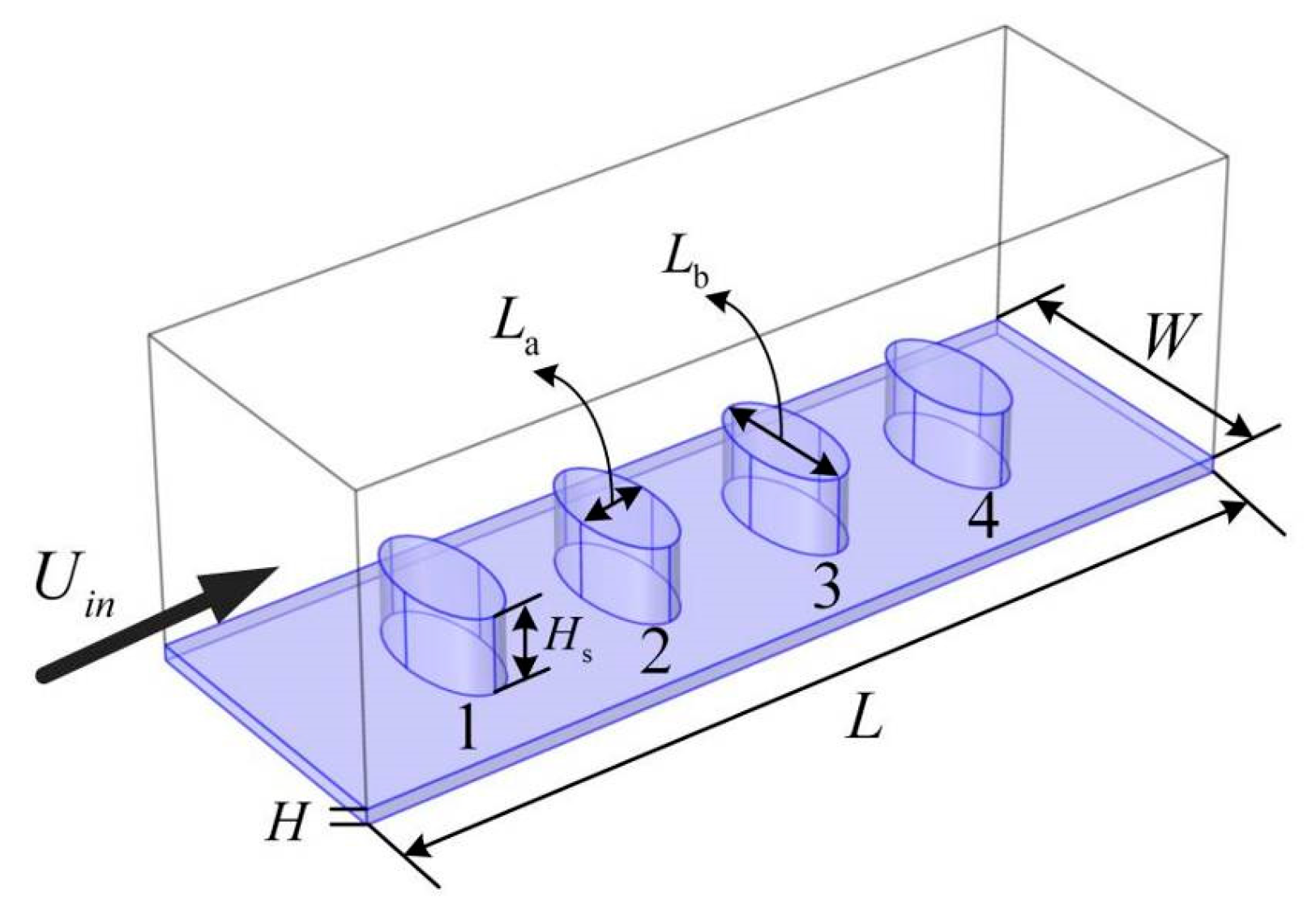
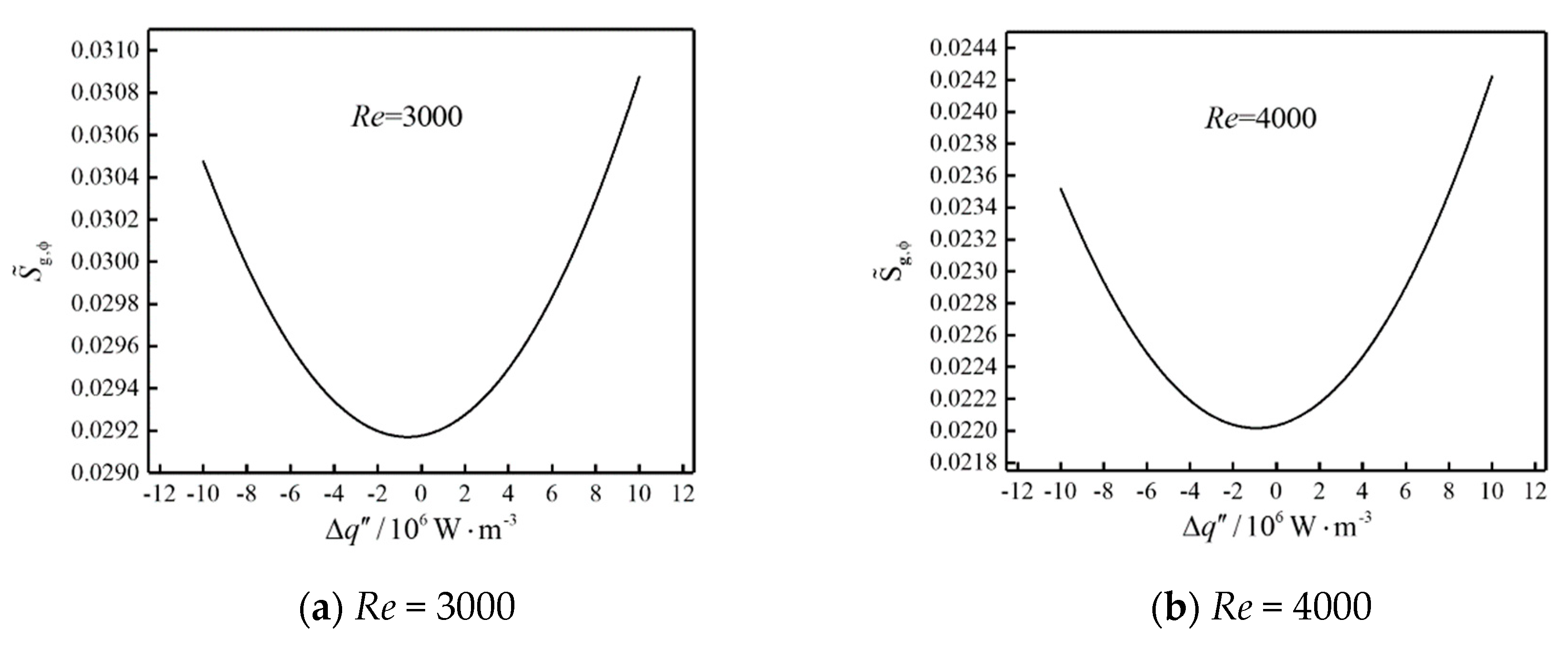
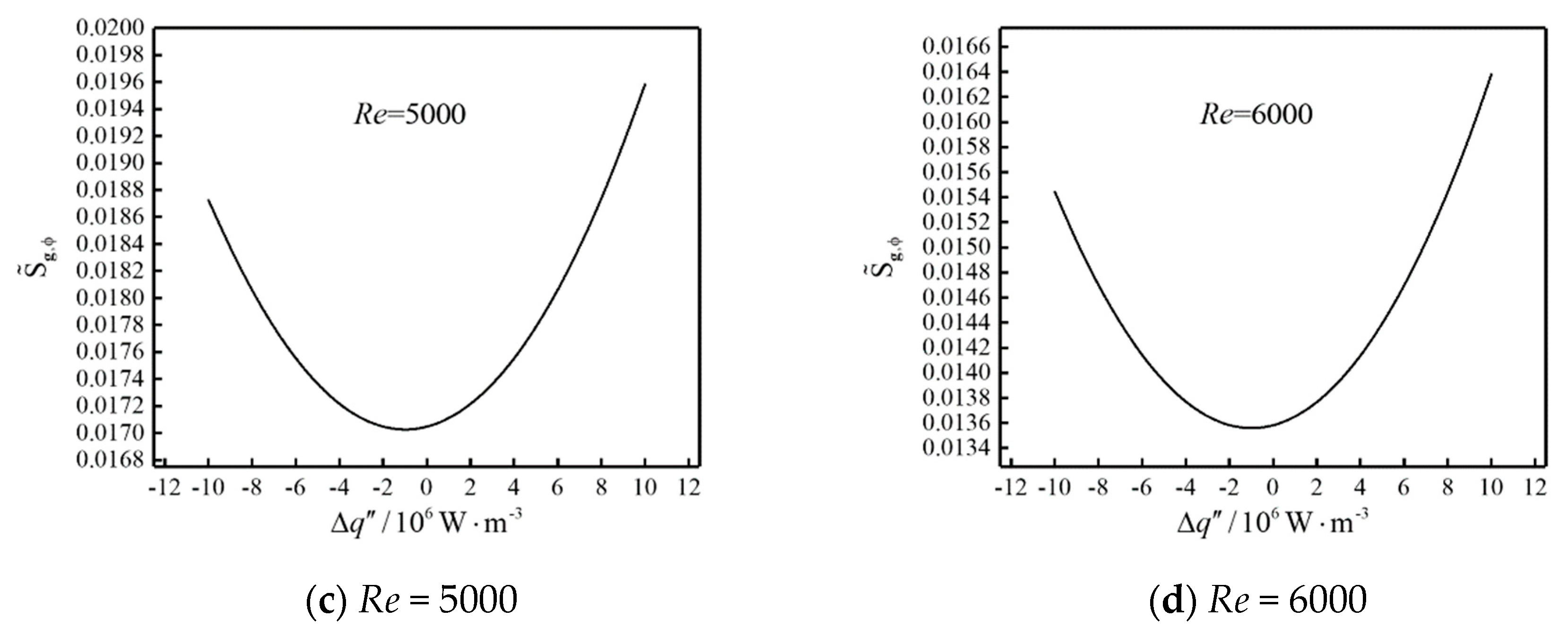
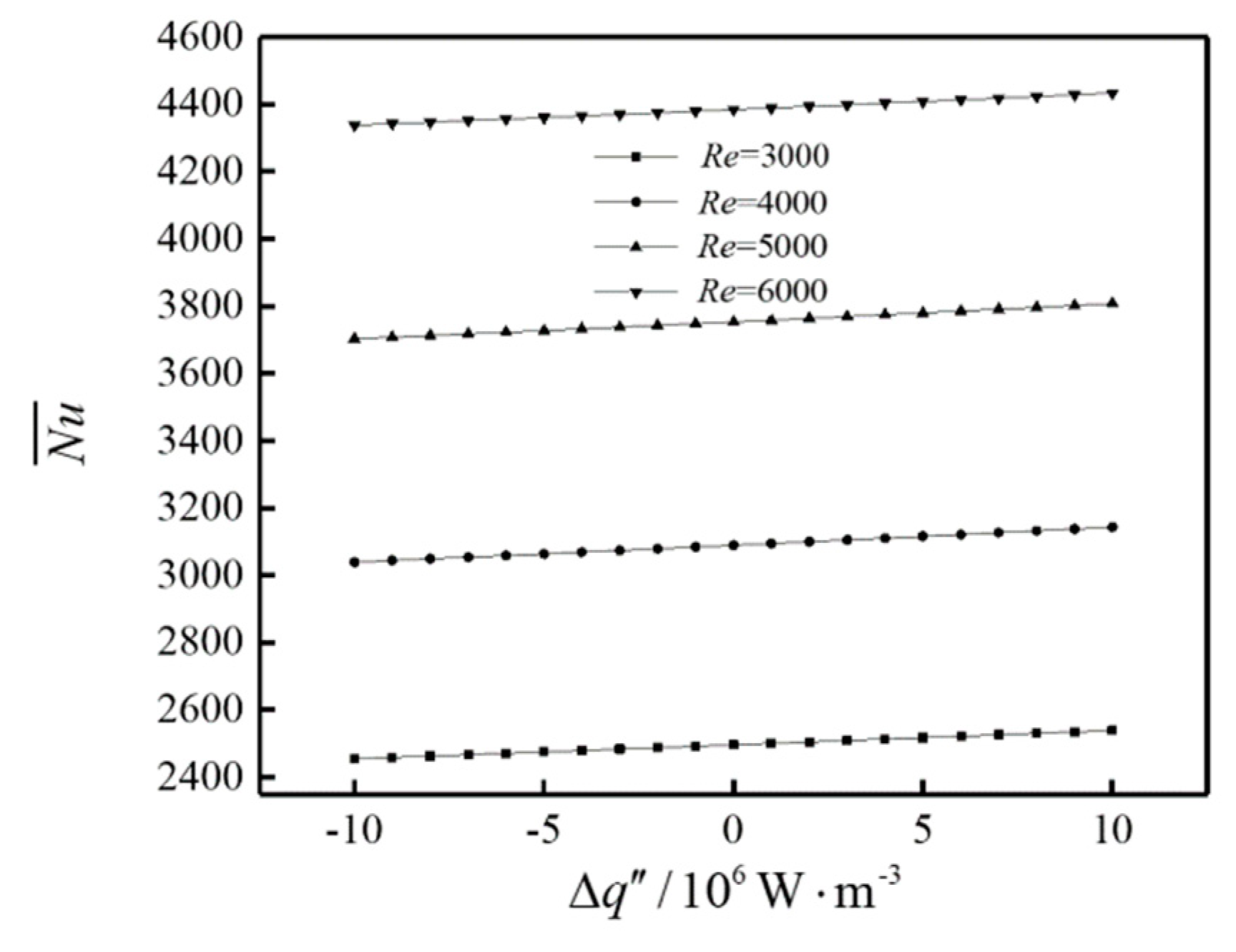

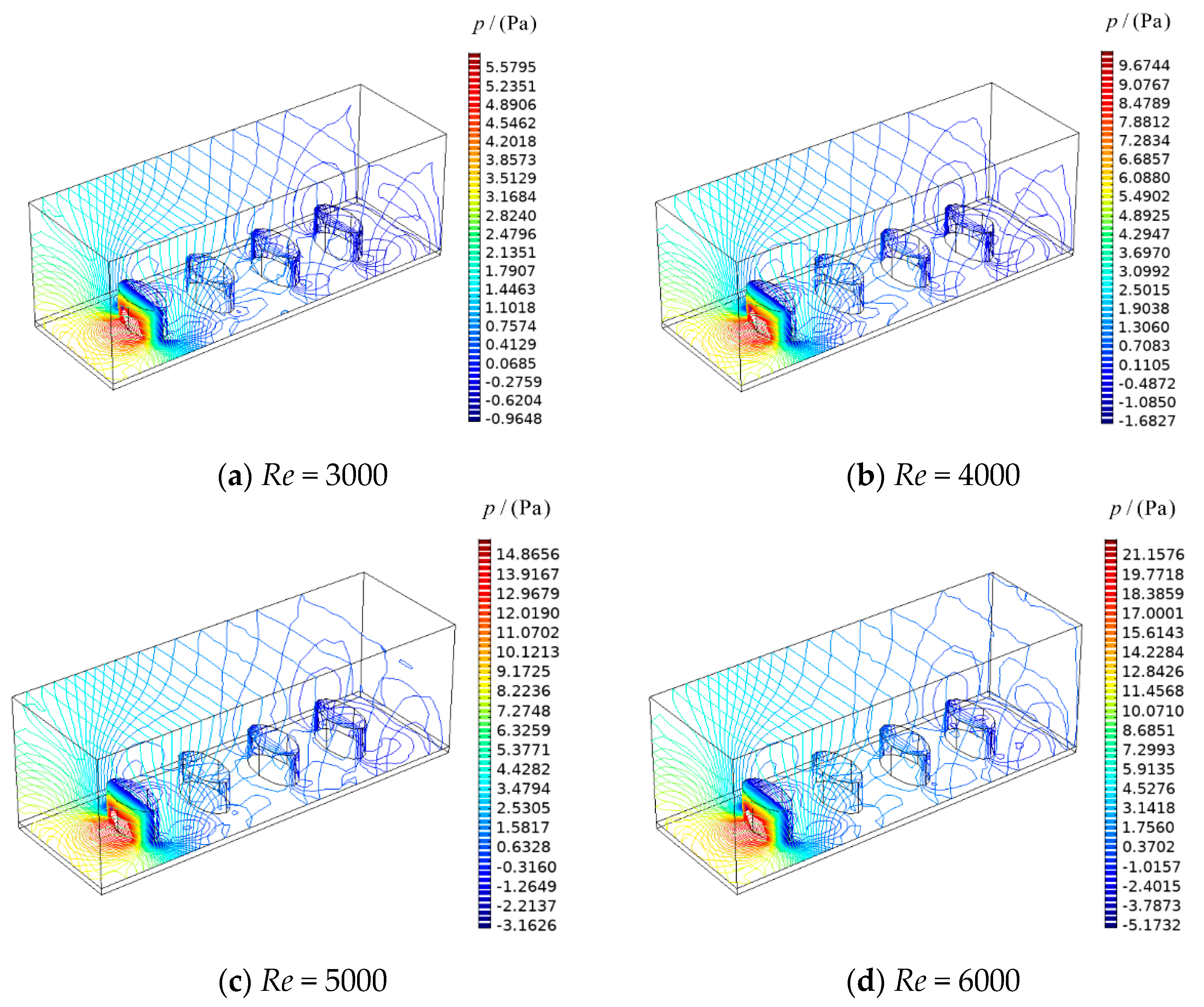
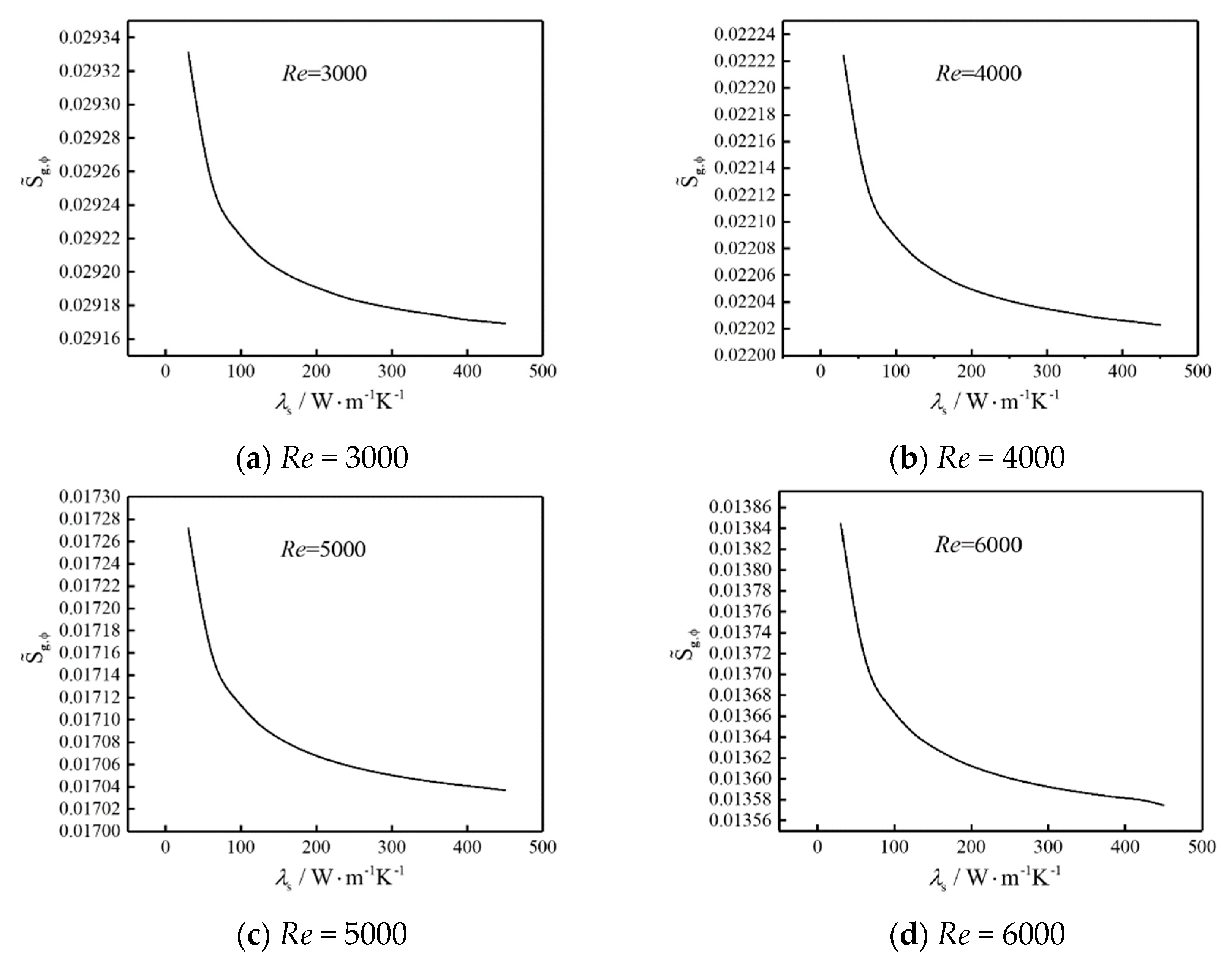
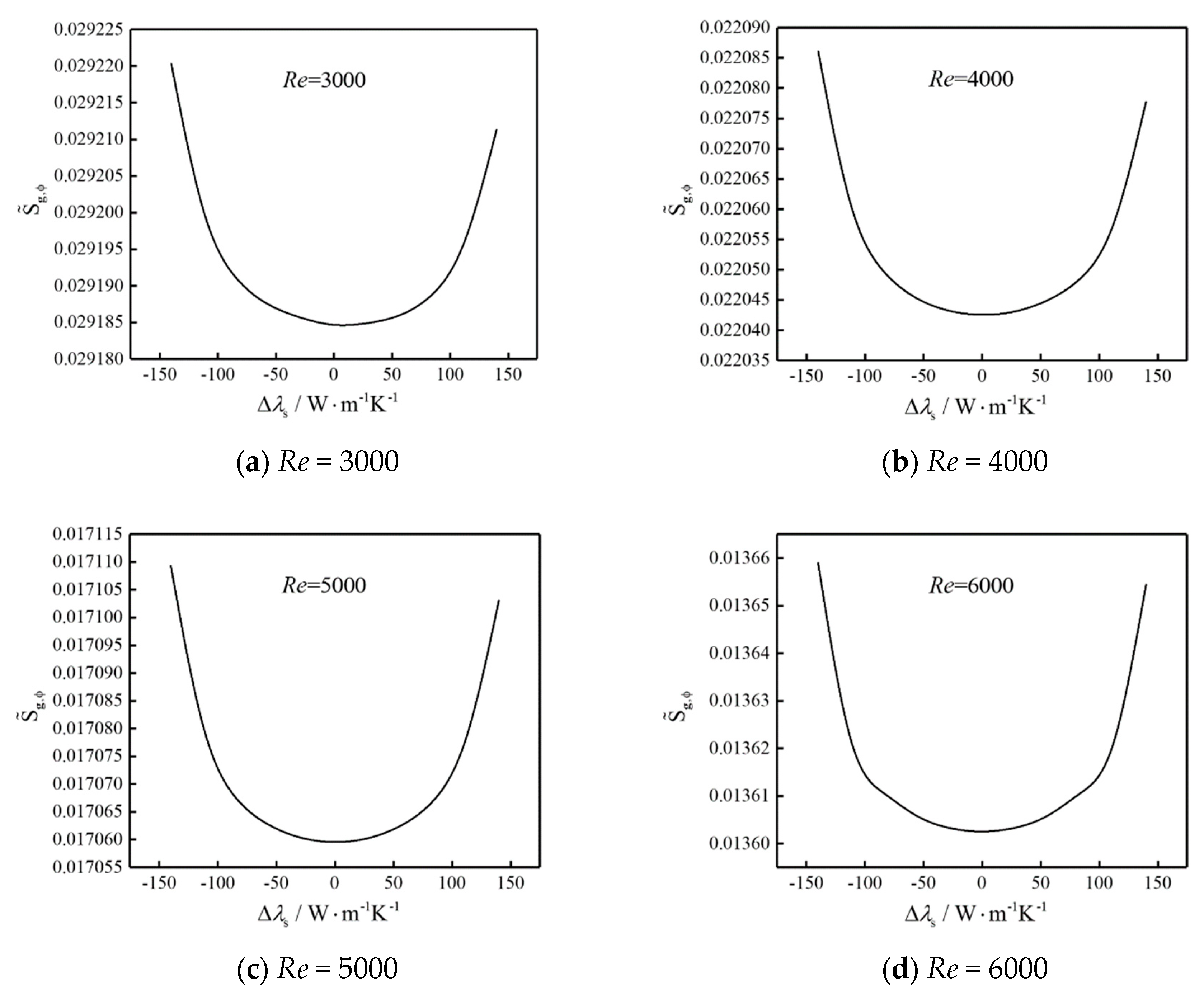
| 0.1 | 0.2 | |
|---|---|---|
| 0.4652 | 0.4835 | |
| [82] | 7.2339 | 13.6509 |
| of this work | 7.1805 | 13.8243 |
| Re | 3000 | 4000 | 5000 | 6000 |
|---|---|---|---|---|
| /106 W·m−3 | −0.6 | −0.9 | −1.0 | −1.1 |
| 0.02919 | 0.02201 | 0.01702 | 0.01355 |
| Re | 2500 | 3000 | 3500 | 4000 | 5000 | 6000 |
|---|---|---|---|---|---|---|
| (Δλs)opt / W·m−1·K−1 | 4 | 6 | 0 | 0 | 0 | 0 |
| 0.03382 | 0.02919 | 0.02530 | 0.02201 | 0.01702 | 0.01355 |
© 2020 by the authors. Licensee MDPI, Basel, Switzerland. This article is an open access article distributed under the terms and conditions of the Creative Commons Attribution (CC BY) license (http://creativecommons.org/licenses/by/4.0/).
Share and Cite
Wang, R.; Xie, Z.; Yin, Y.; Chen, L. Constructal Design of Elliptical Cylinders with Heat Generating for Entropy Generation Minimization. Entropy 2020, 22, 651. https://doi.org/10.3390/e22060651
Wang R, Xie Z, Yin Y, Chen L. Constructal Design of Elliptical Cylinders with Heat Generating for Entropy Generation Minimization. Entropy. 2020; 22(6):651. https://doi.org/10.3390/e22060651
Chicago/Turabian StyleWang, Rong, Zhihui Xie, Yong Yin, and Lingen Chen. 2020. "Constructal Design of Elliptical Cylinders with Heat Generating for Entropy Generation Minimization" Entropy 22, no. 6: 651. https://doi.org/10.3390/e22060651
APA StyleWang, R., Xie, Z., Yin, Y., & Chen, L. (2020). Constructal Design of Elliptical Cylinders with Heat Generating for Entropy Generation Minimization. Entropy, 22(6), 651. https://doi.org/10.3390/e22060651






